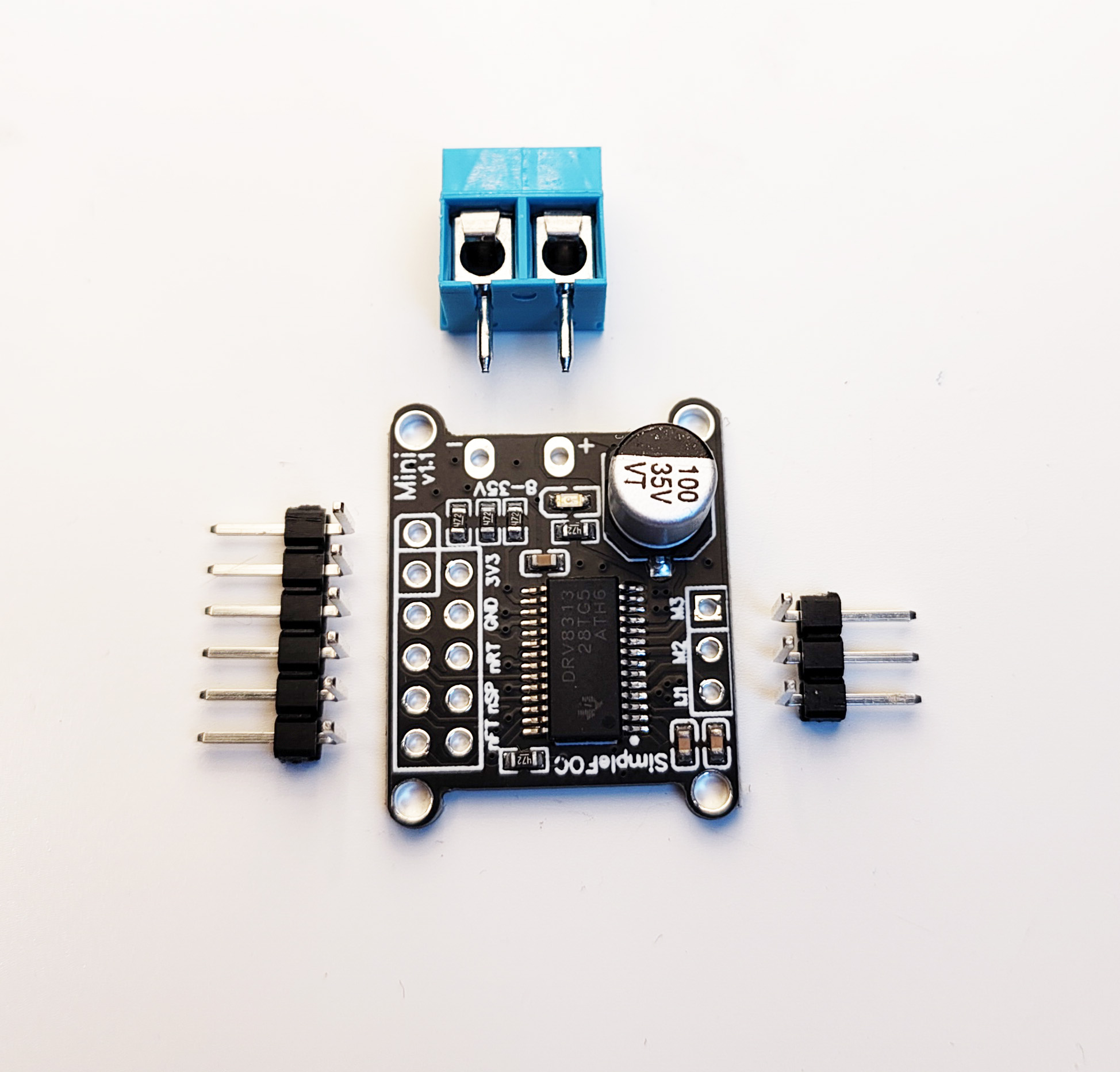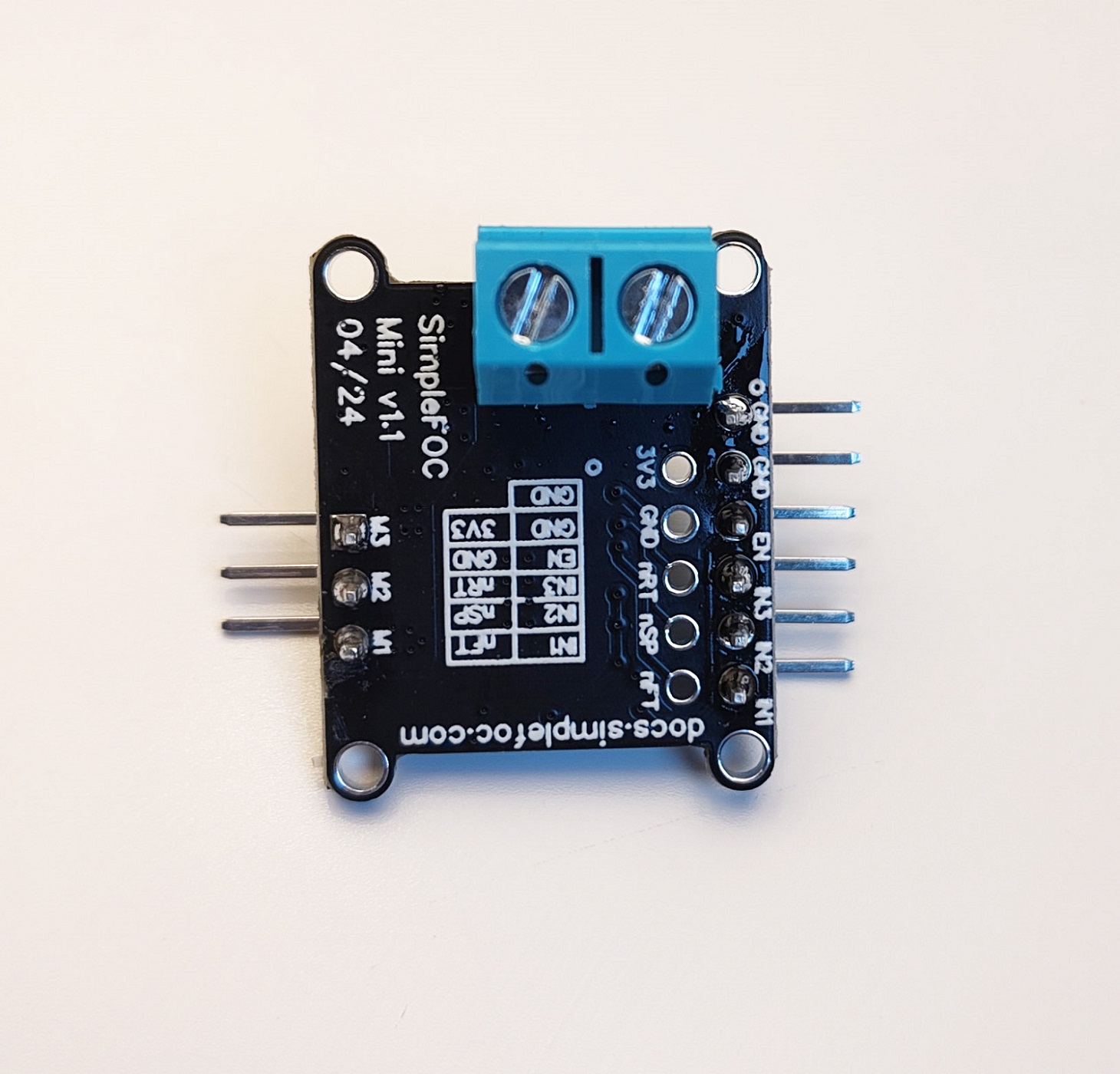Product
SimpleFOCMini V1.1
Arduino SimpleFOCMini is a small-package, low-cost, modular and user-friendly driver for running gimbal BLDC motors with FOC algorithm.
Motivation
As for the SimpleFOCShields, the main motivation of this board is to make using low-power BLDC motors in hobby applications more accessible.
The main goals of this board however are:
- Produce a small package BLDC driver that still has all the features of the SimpleFOCShield v1
- Make it in away to be a minimal working example for users that are interested to build their own boards based on the DRV8313 chip.
- Make it as cheap as possible.
- Use only long-term (as of mid 2022) available components.
This board in combination with the SimpleFOClibrary will give you a simple and intuitive way to control the BLDC motors' current, torque, velocity and position. And this board can be used as a drop in replacement for the SimpleFOCShield v1.
Features
-
Plug & play
Using SimpleFOClibrary and any gimbal motor. -
DRV8313 based
Overcurrent protection, Fault detection
Deep-sleep more capability
Find out more datasheet -
3.3V Voltage regulator
DRV8313 has integrated 3.3 voltage regulator which you may use to power you microcontroller.
-
Small package
26mm x 20mm -
Open-Source
Schematics and fabrication files fully available on github and EasyEDA. -
Max Power 100W
Max current 3A, Power supply 8-35V. -
Low-cost
JLCPCB production range 3-5€ per board
-
No current sensing!
This board does not integrate any form of current sensing!
SimpleFOCMini supports the voltage based torque control that is not based on the current measurement - read more in our docs.
SimpleFOClibrary is capable of estimating overall current passing through the motor, given proper motor parameters. This value can later be used to control estimated torque of the motor and/or limit the estimated current.
If your application requires precise current control please check out the SimpleFOCShield v2.
Good news is that most of gimbal and other low-power BLDC motors do not require current sensing to exploit their full potential.
-
BEWARE 📢 : SimpleFOCMini is designed for gimbal motors
SimpleFOCMini has been designed for gimbals motors with internal resistance around 10 Ohms. Using this board with high-power drone motors may burn the DRV8313 chip integrated on the board. The chip can handle up to 3Amps of current for short periods of time, but in for long-term operation (without the heat-sink) the current should stay under 2 Amps.
- It is possible to use this board with low resistance motors but it requires a bit of experience and it is not recommended for beginners. Ask community about it!
What can I do with this board?
Possible applications range all the way from simply substituting a servo motor in your project, over the high precision motion control of camera gimbals all the way to the highly dynamical applications such as robotics.
This board can also be a cool platform for student projects, to make experiments such as ball and plate, inverted pendulums, segways, inertia wheels and similar. These setups are usually very expensive and hard to calibrate and design.
-
SimpleFOCMini capabilities
This board can be used as a low-profile replacement of the SimpleFOCShield v1 and in that way any project that is available for the shield (Haptic example, Reaction wheel inverted pendulum, SimpleFOCBalancer, ...) can be carried out using this board as well.
Project examples
Reaction Wheel Inverted Pendulum

This is a project of designing and controlling the reaction wheel inverted pendulum based entirely on Arduino SimpleFOClibrary and SimpleFOCShield .
- Arduino UNO using SimpleFOClibrary and SimpleFOCShield
- All CAD designs available for modification and STL files provided
- State-space LQR controller
- Very simple to assemble, configure and setup.
Documentation
The aim of the SimpleFOClibrary and SimpleFOCMini is to demystify the FOC algorithm and to provide the community a simple way to use this powerful algorithm in their projects. Therefore this board is completely open source and fully documented. If you are interested in manufacturing this board on your own, make sure to check the board fabrication documentation section. Don't hesitate to contact me if you have any suggestions or need any more details about the board!,










